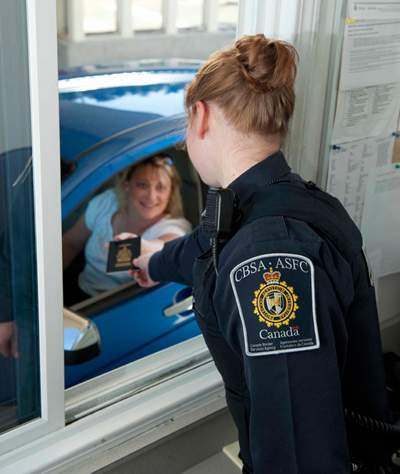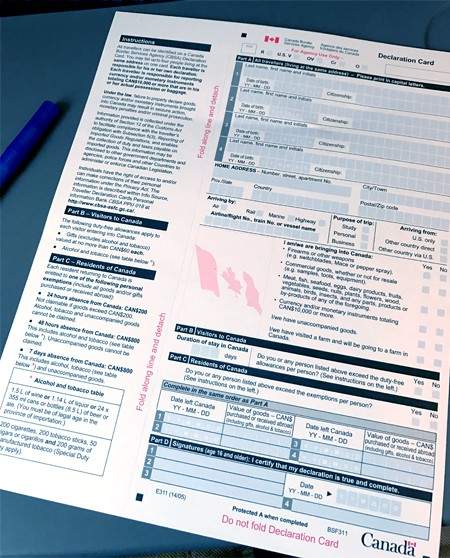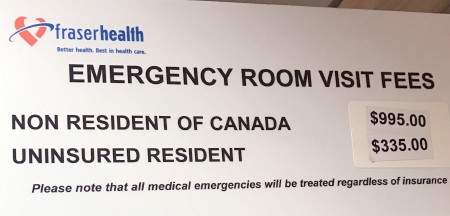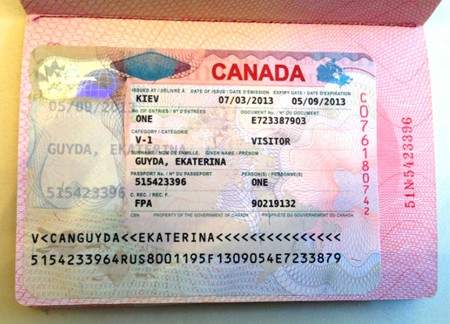No
Visiting Canada and Canadian Tourism
Over 18 million foreigners visit Canada every year making tourism an over $80 billion-a-year Canadian industry — bigger than lumber, fishing, and farming combined. So why not join in?
Why come to Canada?
Canada is a large, diverse country with a lot going for it, but most tourists are drawn to a few of the same things:
Nature — Canada is one of the most beautiful countries in the world, full of picturesque forests, mountains, and lakes that make it a fantastic place for camping, hiking, or just wandering around and admiring.
Winter Sports — Canada’s snowy climate and mountainous geography has produced no shortage of must-visit parks and resorts for anyone interested in skiing, snowboarding, snowshoeing, or any other activity best enjoyed in the cold.
Cities — Canada is home to several large, modern cities that anyone with a taste for urban life will be able to appreciate.
Cost — The Canadian dollar is generally quite weak in comparison to other currencies, which make it a very affordable option for people without too much money in their travel budgets.
The rest of this chapter deals with general information about traveling to Canada. For more information on things to see and do in Canada’s four most popular tourist destinations, please see the specific chapters on British Columbia tourism, Alberta tourism, Ontario tourism, and Quebec tourism.
What language do they speak in Canada?
Foreigners are sometimes confused by Canada’s language situation. Officially, Canada has two official languages, French and English. However, this is mostly just a matter of government policy. The vast majority of Canadians only speak English, and lack even basic skills in French. French-speaking tourists should not expect to speak French in cities like Vancouver, Toronto, or Calgary.
The capital city of Ottawa is more functionally bilingual than most Canadian cities, and all museums and government-related attractions will feature signs and brochures in both French and English. Staff at popular attractions will likely be fluently bilingual as well, as will many employees of popular stores and restaurants. It helps to ask, however.
The famous city of Montreal, in the province of Quebec, is the most bilingual city in Canada and most residents, particularly those who live and work in the downtown core, can speak fluent French and English. It is not considered controversial in Montreal to speak either French or English to a stranger and assume the other person will understand. In other parts of Quebec, however, rates of English fluency are much lower and it may be considered offensive to speak English to a stranger without first asking for permission.
Downsides of Canada
To avoid unhappy surprises, would-be tourists to Canada should be aware of the following potential disappointments before they go:
Bad weather — Unless you are specifically traveling to enjoy winter activities (see above), there are generally only a few months of the year (usually around June to September) in which Canada’s weather will be mild enough to enjoy. Canadian winters, and even parts of spring and fall, are often cold, dark, snowy, and wet, which can make tourist activities difficult or unpleasant.
Long travel distances — Canada is an enormous country and its main cities are all spread quite far apart from each other. Tourists, particularly European tourists unfamiliar with the vastness of North America, are sometimes disappointed to learn that they will probably only be able to see a rather small part of Canada on their trip. Visiting multiple major Canadian cities on a single vacation — for example, Vancouver, Toronto, and Montreal — would be extremely time-consuming and likely cost thousands of dollars in domestic travel alone.
“America Jr.” — Some tourists are disappointed to discover that Canada is extremely similar to the United States. Travelers familiar with America should not expect to encounter a strikingly different culture in Canada. Stores, brands, food, entertainment and so on will be overwhelmingly American. Though the international press likes to emphasize Canada as being a more “liberal” country than the US, Canadians will probably not seem very different from Americans in day-to-day encounters.
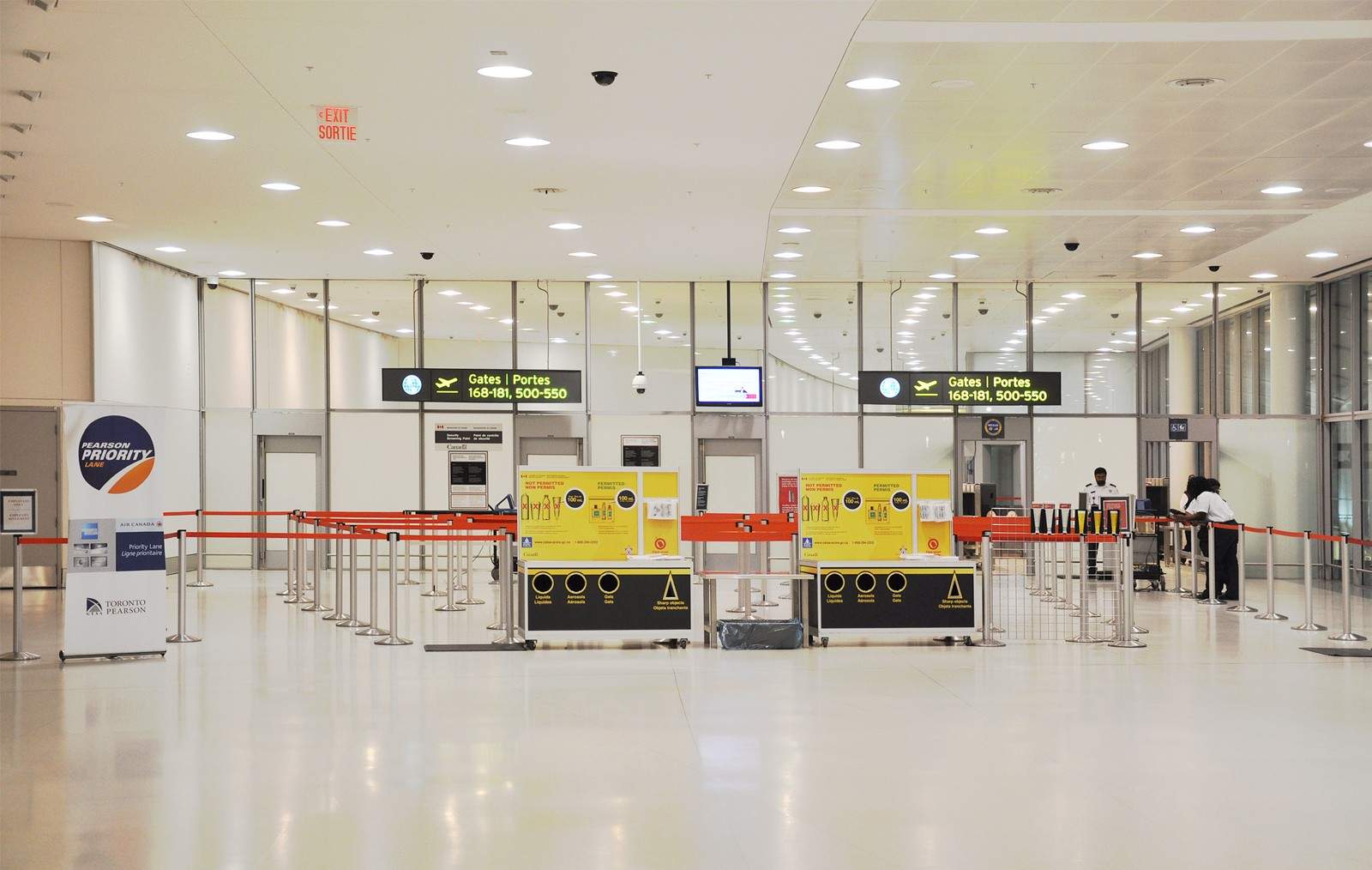
Security checkpoint at Toronto's Pearson International Airport.
Serjio74/Shutterstock
How to Visit Canada
Customs and Visas
Canada does not treat all international visitors the same; citizens of certain countries will have an easier time entering Canada than others. All foreign visitors to Canada, however, must bring a valid passport from their home country.
Residents of the United States have the easiest entry to Canada, and don’t require anything other than a passport to get in. Residents of Great Britain, western Europe, and a few other countries have to obtain an Electronic Travel Authorization (ETA) before they can enter. This is a very easy process that only takes a couple of minutes and should be done online before you leave. Once completed, an ETA lasts for five years or until you get a new passport.
Residents of countries not covered by the ETA program can only visit Canada after obtaining a short-term visitor’s visa. Applications can be done online, through the mail, or at an overseas Canadian consulate. They take a couple weeks to process and usually cost around $200. For more information, see the Government of Canada’s visitor eligibility questionnaire.
It is illegal for anyone, from any country, to enter Canada to work or live without first obtaining a long-term visa, which are much more complicated to apply for, and take many months to be approved.
Crossing the Canadian Border
Anyone entering Canada from a foreign country by land, sea, or air — including Canadians themselves — are required to have an interview with a Canadian border guard at their point of entry so it can be determined they are a safe and legal visitor. Exactly how long and invasive this interview will be depends very much on where you are coming from, why you want to visit, whether you have completed any authorizations you may need, and how clearly you communicate these facts. It pays to be honest, cooperative, and informed.
- Canada Border Services Agency
- Wait Times Now, estimated wait times for major Canadian border crossings
It should be remembered that while foreigners enjoy various legal rights after they enter Canada (see below), no foreigner has the right to get into Canada just because they want to. Canadian border guards have the power to deny anyone entry to Canada for any reason. Possessing a criminal record, a history of subversive political activity, dangerous diseases, suspicions of drug trafficking, or just broadly suspicious behavior are all common grounds for refusal of entry to Canada.
Ever since the terrorist attacks of September 11, 2001 Canadian security forces have been extra vigilant about terrorist threats, particularly from the Islamic world. Would-be visitors from the Middle East or parts of Africa, or those with a history of visiting such places, may find themselves subject to increased scrutiny.
Bringing Goods to Canada
It is illegal for foreigners to bring products into Canada to sell without first going through the complex procedures for engaging in international commerce. If you cross the border with more stuff than a reasonable person would assume you need for a trip, the authorities may conclude you are probably intending to illegally sell goods. The only exception is a maximum $60 worth of “gifts.”
Tobacco and liquor products are counted separately, and foreigners can bring a fair bit of both into Canada. The current tobacco limit is quite generous; you can bring up to 200 cigarettes, 50 cigars, and 200 grams of tobacco, if you so choose. The liquor limit is stricter: you can only bring 1.5 litres of wine, 1.13 litres of another liquor, or a 24-pack of beer. Bringing food products into Canada is generally a hassle, as there are very specific rules and limitations for just about every type.
Dangerous goods, like guns, other weapons, and fireworks can be imported, but have their own particular rules. A few very specific things are likewise banned in Canada for safety reasons and are thus illegal to bring into the country, such as certain kinds of kites and baby products. A complete list can be found on the Canadian Government’s official prohibited consumer products list. It’s also illegal to import what the government describes as “obscenity and hate propaganda” which includes any movies, books, comics, or magazines that contain, in the opinion of the border guard, overly hateful, perverted, gory, terroristic, or violent content.
Traveling Inside Canada
Laws for Foreigners
This should hopefully go without saying, but foreigners have to obey Canadian laws while in Canada. Those who do otherwise can be charged, arrested, sentenced, and imprisoned just like Canadians. At the same time, the legal protections granted to Canadians by the Canadian Constitution also apply to foreigners visiting the country. This includes the right to avoid self-incrimination, the right to consult a lawyer, and the right to dispute before a judge any charges or fines imposed by a police officer.
Canada has extradition treaties with more than half the world’s countries, meaning foreigners who commit a crime in Canada but leave the country before they are caught or punished can be caught by local police and forced to return to Canada to face justice (and vice-versa). Only in very rare situations will a foreigner accused of a crime in Canada be tried and punished for it by their own country’s justice system.
Getting Around in Canada
Air travel
Flights within Canada are notoriously expensive, with the average domestic flight costing at least $300, plus airport fees and taxes which usually add an additional $40 or so. The country has three national airlines, Air Canada (airline codes: 014, AC or ACA, part of the Star Alliance airline coalition) and WestJet (838, WS, WJA, part of its own 16-airline alliance) which are largely domestic, and Air Transat (649, TS, TSC) which is mostly international. Canada does not have a major discount or budget airline, though in recent years the major airlines have been experimenting with budget spin-offs, such as Air Canada Rouge and Westjet’s Swoop. Flights to northern Canada, and especially within northern Canada, are extremely expensive, often a thousand dollars or more, and to get to certain remote regions travelers must use a special northern airline or a chartered flight.
Every major Canadian city has its own international airport, and many smaller cities too. There are also several considerably smaller regional or domestic airports that exclusively service flights between Canadian cities. Most of Canada’s big city airports are located around 20 kilometers from their city’s downtown core, or about a 30 minute drive. Vancouver and Toronto have trains that go directly from the airport to downtown.
Trains
The railroad played an important role in Canadian history, but trains have now become among the slowest, most expensive ways to travel the country. While trains can be a somewhat convenient way for tourists to travel between large Canadian cities located relatively close to each other, air travel or driving remains much more popular, and may even be cheaper.
VIA Rail is Canada’s primary passenger train service, offering direct service from Vancouver to Toronto (at over 4,000 km, one of the longest train trips in the entire world!), Toronto to Montreal, and Montreal to Atlantic Canada, with stops in all significant cities along the way. Traveling between the axis of Toronto, Ottawa, and Montreal is a popular route. A cross-country Canadian train ride, from one end of the country to the other, will take about four days and cost around $500-$800.
VIA Rail’s Vancouver, Toronto, and Montreal stations also offer connecting trips to the United States, via Amtrak. Several provinces also have limited train service to some of their more remote areas. Cruise-like luxury train services are provided by Royal Canadian Pacific for those willing to pay.
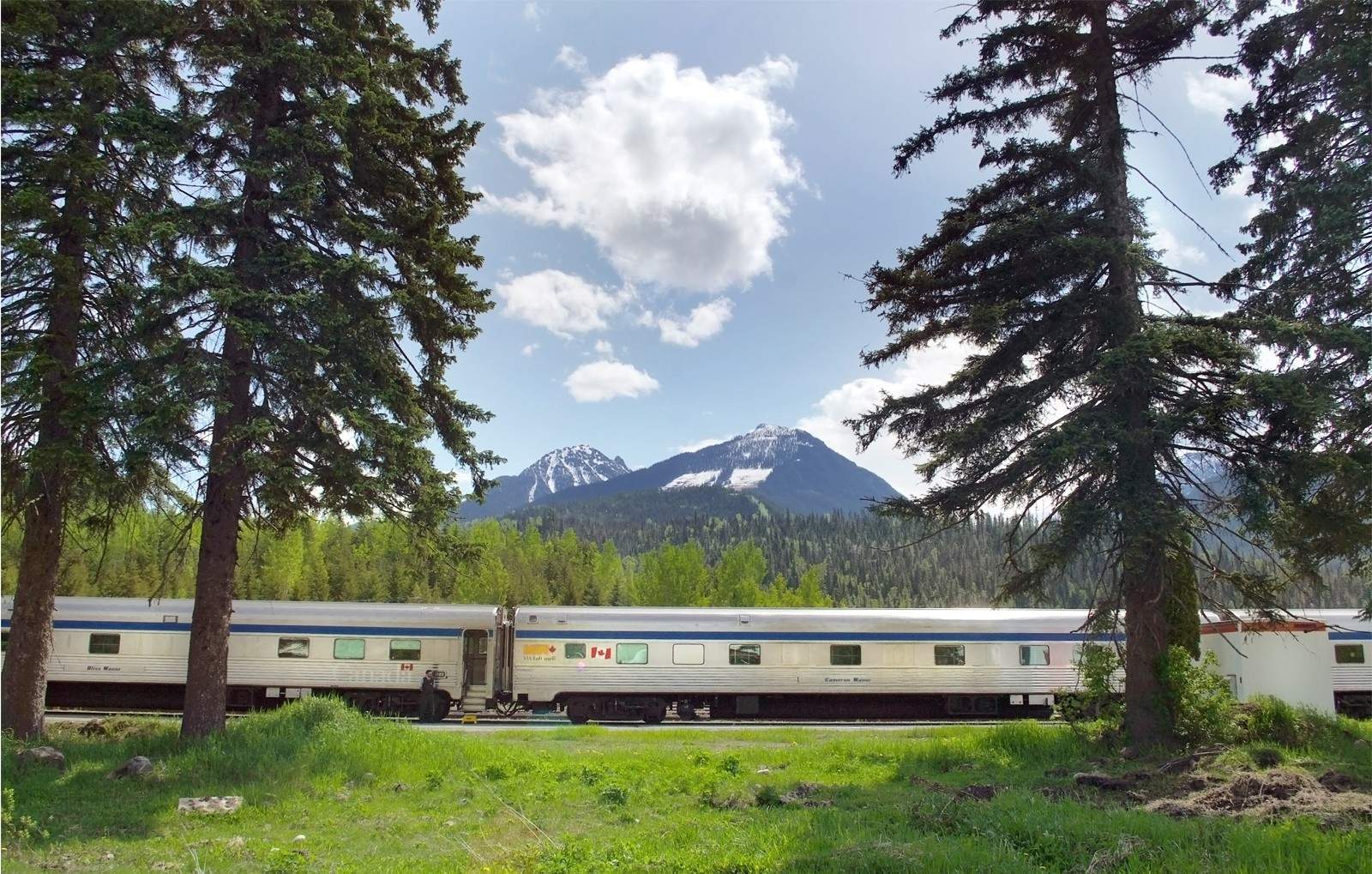
A Via Rail passenger train takes a break in Blue River, British Columbia.
joseph s l tan matt/Shutterstock
Car and Bus Travel
Canada is united by a massive cross-country highway known as the Trans-Canada Highway that extends 7,821 km from the farthest western portion of British Columbia to the farthest eastern part of Newfoundland. It is primarily a west-east corridor, however. Though the Trans-Canada highway does have some northern forks, these do not go very far and none reach Canada’s northern territories. Every province has its own highway system as well, and these often merge into portions of the Trans-Canada highway. Through a combination of national and provincial highways, virtually every part of Canada is reachable by road travel, though in many cases drive times will be incredibly long.
Many tourists enjoy traveling between Canadian cities by charter buses, which are large, comfortable buses featuring modern amenities such as bathrooms and WiFi. In eastern Canada, Greyhound is the dominant charter bus line. Other provinces are serviced by various regional bus companies.
Public Transportation
Most large Canadian cities have relatively sophisticated public transportation systems, with some combination of bus, light-rail train, monorail, subway, street car, and ferry services that can be used to navigate most of the downtown core and surrounding areas. The exact combination of services will vary from city to city (as will the cost of tickets and passes). In most cases, public transportation does not travel to rural areas, though some rural communities may have their own public transportation system.
Shopping in Canada
Canadians use the Canadian dollar (symbol: $) to pay for goods and services, which can be obtained at any ATM machine, which can be found at banks, shopping centres, corner stores, and many other public places. Most Canadian ATMs will accept foreign bank cards, though withdrawal fees can be high. Some smaller, independently-run shops will have a strict “cash only” policy, but these days, most Canadian business will actually prefer to do transactions through credit or debit cards. Visa and Mastercard are the most commonly-used credit card brands in Canada, and many shops will not accept other kinds — though some will, making it a good idea to ask ahead of time.
US dollars are often accepted at Canadian stores, particularly in tourist-heavy areas. Some places may have a policy of accepting US dollars “at face value,” however, meaning American money will not be accepted at its exchange rate worth, but rather treated as if it was worth as much as Canadian money, which is a bad deal.
Foreigners will be charged sales tax on every purchase they make in Canada, through special “value-added tax” known as GST and either PST or HST. Canada does not have a rebate program allowing foreigners to get a refund for the GST, PST, or HST they spend in Canada.
Challenges, dangers and annoyances when visiting Canada
Medical costs
Though Canada offers generous public healthcare insurance, you have to be some form of long-term, legal Canadian resident before the government will pay for your hospital visits or operations. Non-residents will be billed full cost for any medical service performed while in Canada, which is why it always pays to get travelers’ medical insurance.
Canada has some of the world’s cleanest tap water and strict laws to ensure the cleanliness and safety of any meat, dairy, or poultry products sold at restaurants or grocery stores.
Staying Safe in Canada
Canada is generally a safe country, but it has some dangerous places. Every large Canadian city will have a couple of “bad neighborhoods” where criminals tend to congregate and locals generally avoid — particularly after dark — for fear of being harassed, robbed, or assaulted. Unfortunately, these neighborhoods can often be located close to tourist areas, and may seek to take advantage of the obviously confused or foreign. At the same time, most serious, violent crime in Canada tends to occur between people who know each other. Visitors who act confident and use caution and common sense should have little to fear.
Leaving belongings unattended in any public place is generally considered a high-risk activity, and though some businesses may store forgotten items in a “lost and found” collection of lost property, the police — and indeed, most Canadians — will generally be unsympathetic to victims of theft caused by inattentive behavior. People generally lock up their homes, cars, and bicycles before leaving them unsupervised. In rare cases, tourists and locals may be targeted by scam artists looking to cheat them out of money. In big cities, most scams are quite brazen, and usually take the form of a stranger asking for money on some sympathetic pretext, such as a phony personal emergency or phony charity. In some cases, a thief may attempt to quietly sell stolen goods to a stranger. Beggars can be common in some large Canadian cities as well. Many Canadians regard them with indifference, believing them to be scam artists.
The police can be called anytime in Canada by dialing 9-1-1 on the telephone. Canadian police are obligated to treat crimes committed against foreigners exactly the same as crimes against Canadians.

